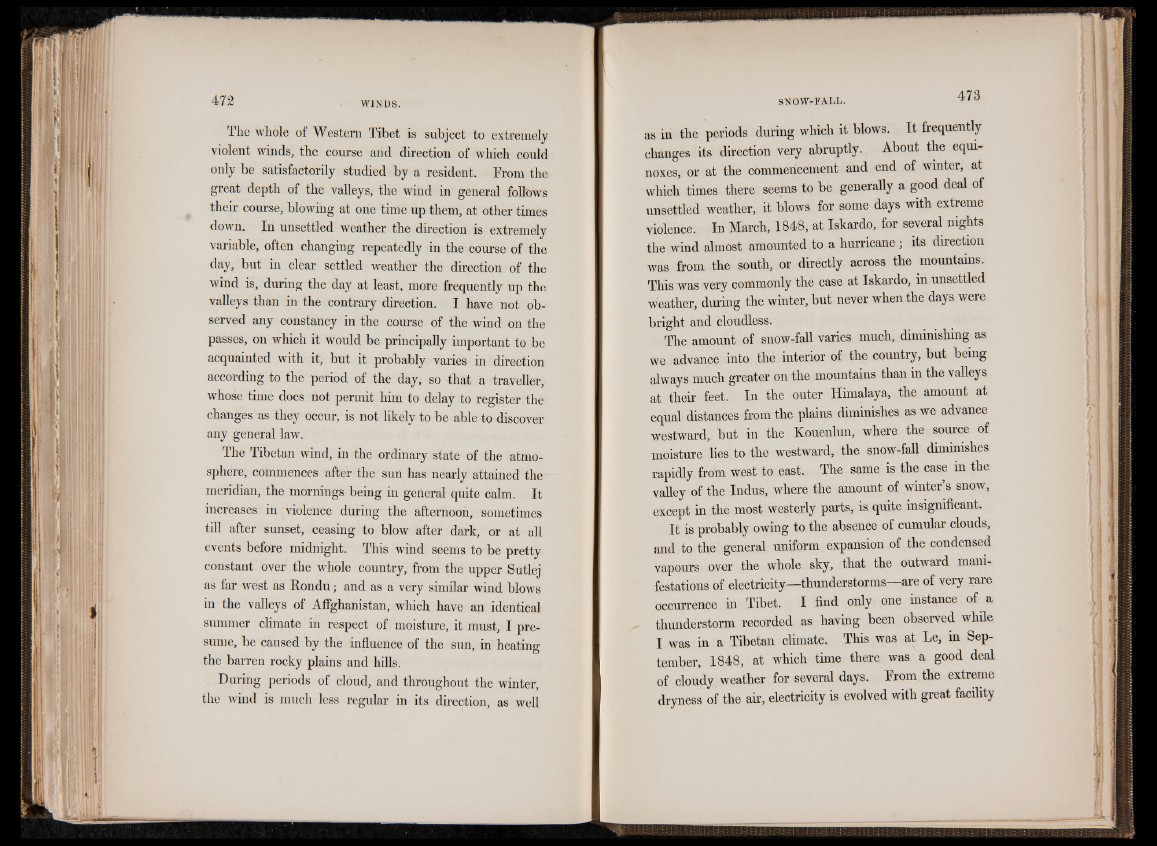
The whole of Western Tibet is subject to extremely
violent winds, the course and direction of which could
only be satisfactorily studied by a resident. From the
great depth of the valleys, the wind in general follows
their course, blowing at one time up them, at other times
down. In unsettled weather the direction is extremely
variable, often changing repeatedly in the course of the
day, but in clear settled weather the direction of the
wind is, during the day at least, more frequently up the
valleys than in the contrary direction. I have not observed
any constancy in the course of the wind on the
passes, on which it would be principally important to be
acquainted with it, but it probably varies in direction
according to the period of the day, so that a traveller,
whose time does not permit him to delay to register the
changes as they occur, is not likely to be able to discover
any general law.
The Tibetan wind, in the ordinary state of the atmosphere,
commences after the sun has nearly attained the
meridian, the mornings being in general quite calm. It
increases in violence during the afternoon, sometimes
till after sunset, ceasing to blow after dark, or at all
events before midnight. This wind seems to be pretty
constant over the wbole country, from the upper Sutlej
as far west as Rondu; and as a very similar wind blows
in the valleys of Affghanistan, which have an identical
summer climate in respect of moisture, it must, I presume,
be caused by the influence of the sun, in heating
the barren rocky plains and hills.
During periods of cloud, and throughout the winter,
the wind is much less regular in its direction, as well
as in the periods during which it blows. It frequently
changes its direction very abruptly. About the equinoxes,
or at the commencement and end of winter, at
which times there seems to be generally a good deal of
unsettled weather, it blows for some days with extreme
violence. In March, 1848, at Iskardo, for several nights
the wind almost amounted to a hurricane ; its direction
was from the south, or directly across the mountains.
This was very commonly the case at Iskardo, in unsettled
weather, during the winter, but never when the days were
bright and cloudless.
The amount of snow-fall varies much, diminishing as
we advance into the interior of the country, but being
always much greater on the mountains than in the valleys
at their feet. In the outer Himalaya, the amount at
equal distances from the plains diminishes as we advance
westward, but in the Kouenlun, where the source of
moisture lies to the westward, the snow-fall diminishes
rapidly from west to east. The same is the case m the
valley of the Indus, where the amount of winter’s snow,
except in the most westerly parts, is quite insignificant.
It is probably owing to the absence of cumular clouds,
and to the general uniform expansion of the condensed
vapours over the whole sky, that the outward manifestations
of electricity—thunderstorms—are of very rare
occurrence in Tibet. I find only one instance of a
- thunderstorm recorded as having been observed while
I was in a Tibetan climate. This was at Le, in September,
1848, at which time there was a good deal
of cloudy weather for several days. From the extreme
dryness of the air, electricity is evolved with great facility